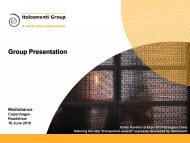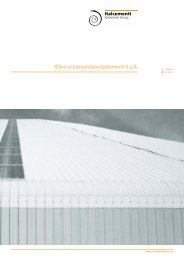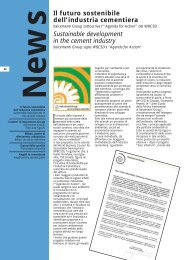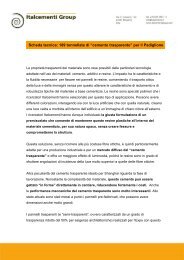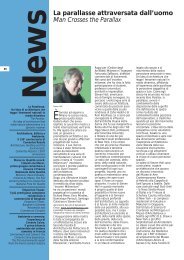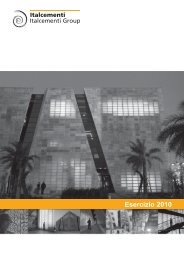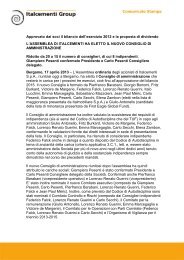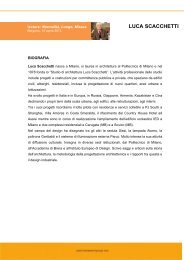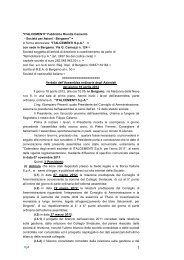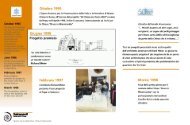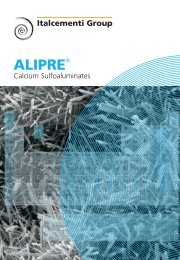2012 Annual Report - Italcementi Group
2012 Annual Report - Italcementi Group
2012 Annual Report - Italcementi Group
Create successful ePaper yourself
Turn your PDF publications into a flip-book with our unique Google optimized e-Paper software.
However, with respect to the definition of the managers’ expected profile, it is based on three essential<br />
elements:<br />
i) general management skills and skills specific to the industry where the Company operates;<br />
ii) performance and potential: the performance level reflects the individual’s assessment in his/her current role,<br />
and his/her potential reflects the ability to expand the scope of action and complexity of responsibilities;<br />
potential is determined by agility in learning, ambition and skills, and is articulated on three different axes:<br />
functional usability, inter-functional usability and geographical usability;<br />
iii) conformity to the role, in comparison with the open market.<br />
The combination between the expected managerial profile and the risk assessment for each position forms the<br />
basis for possible actions on the market: in particular, in case of high risk, a scouting of external candidates will<br />
be performed. The succession planning process for senior positions, as approved by the Board of Directors, is<br />
primarily focused on the business and expectations for the position in the future. It also provides a solid<br />
coverage for less urgent successions and a contingency plan for crisis situations.<br />
There have been a total of 54 interviews so far, which began on September 29, <strong>2012</strong> and ended on February<br />
18, 2013; feedback reports are currently being drafted, 10 of which have already been completed and<br />
delivered to the parties concerned.<br />
Establishment of committees<br />
In order to ensure the effective performance of its functions, the Company’s Board of Directors has set up an<br />
internal Remuneration Committee and an Control and Risk Committee whose resolutions have a consultative<br />
and advisory nature and do not bind the Board.<br />
Moreover, pursuant to the rules applicable to transactions with related parties, the Board has, upon adoption of<br />
the relevant procedure, established an internal Committee for Transactions with Related Parties, composed of<br />
independent directors only, and it is composed of the same members as the Control and Risk Committee.<br />
In carrying out their functions, the above mentioned committees are entitled to access corporate information<br />
and functions necessary for the performance of their duties, and may use external consultants at the expense<br />
of the Company.<br />
Each Committee appoints a secretary, who does not need to be a member thereof and is entrusted with the<br />
task of drawing up the minutes of the meetings.<br />
However, in accordance with its shareholder structure characterized by the stable presence of one controlling<br />
shareholder with the absolute majority of shares entitled to vote, the Company decided not to proceed with the<br />
establishment of a “Appointment Committee”.<br />
a) Control and Risk Committee<br />
In compliance with the provisions of the Code, the Control and Risk Committee has the task of supporting,<br />
through adequate preparatory work, the assessments and decisions of the Board of Directors relating to the<br />
Internal Control and Risk Management System, as well as those regarding the approval of interim financial<br />
statements.<br />
The Control and Risk Committee consists of four members, all non-executive and independent. All of its<br />
members have an adequate expertise in accounting and finance, as required by the Code for at least one of<br />
them.<br />
During <strong>2012</strong>, the Control and Risk Committee met 7 times always with the attendance of all of its members.<br />
The average duration of its meetings was approximately two hours. 5 meetings were attended by all<br />
members of the Board of Statutory Auditors; one meeting was attended by two statutory auditors and the<br />
remaining meeting by one statutory auditor.<br />
During fiscal year <strong>2012</strong>, the Committee, among other things:<br />
184



